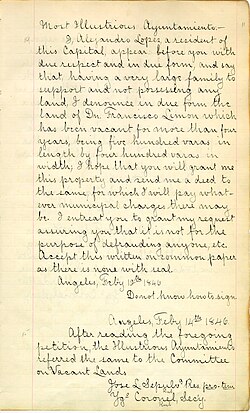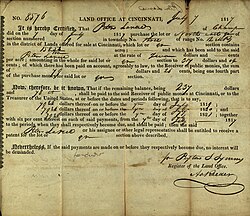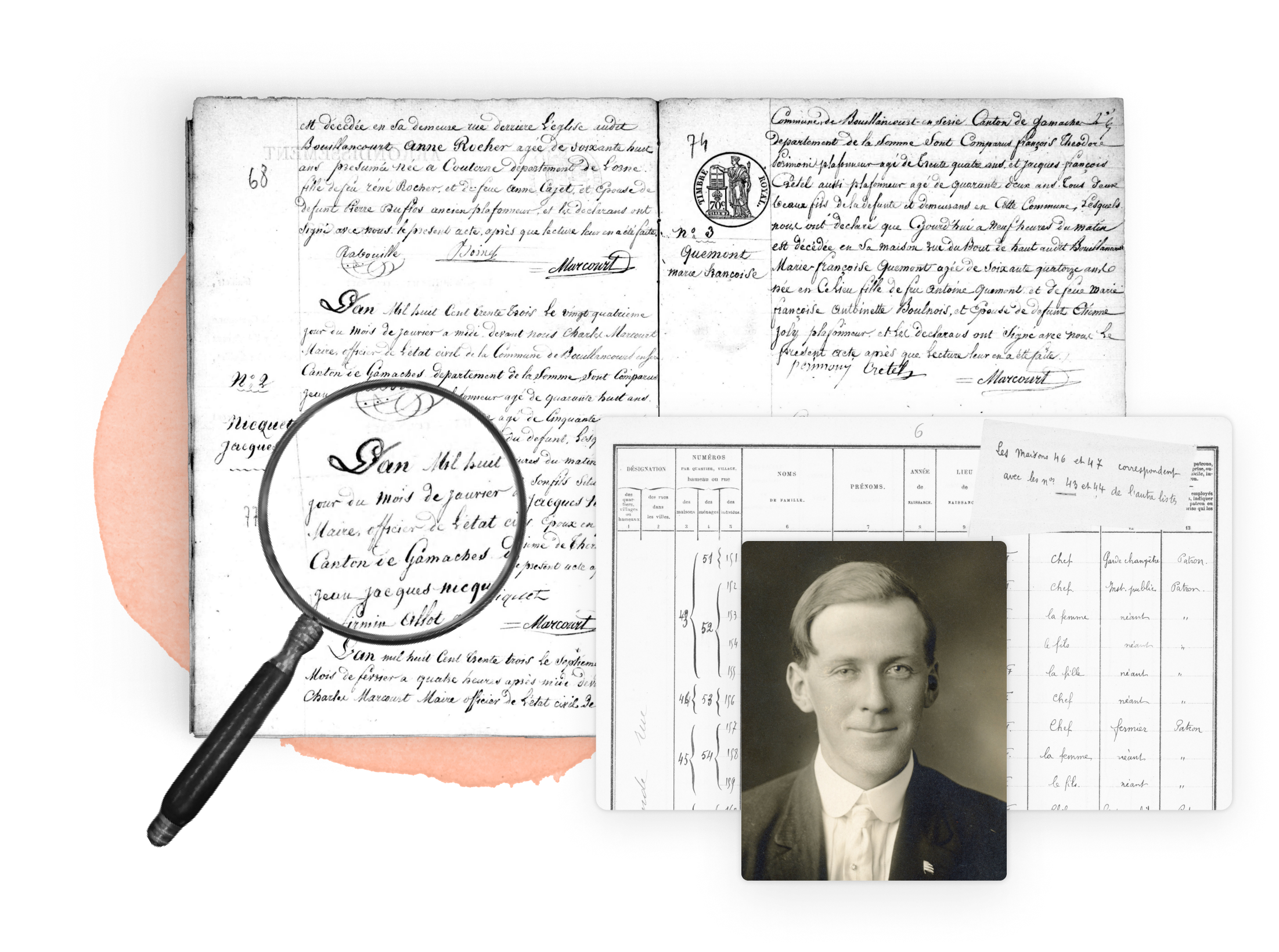
Land records document the sale or transfer of land. Land may be conveyed from the government to an individual or from an individual, couple, or group to another individual, couple, or group. Land records will document this process and the chain of ownership of that land and are used to provide evidence of title, facilitate transactions, and prevent unlawful disposal. In common law countries, particularly in jurisdictions in the Commonwealth of Nations, when replacing the deeds registration system, title registrations are broadly classified into two basic types: the Torrens title system and the English system, a modified version of the Torrens system.[1]
How someone acquires land changes over time and depends on the location. For example, military service during a war may result in a payment or promise of land. Governments may set up lotteries or specific legal acts so that citizens can acquire land. Land records differ from other genealogy records in that they don't provide vital record information, and they are not something that all ancestors leave behind. Land records might be helpful in your research if your ancestor was able to purchase or inherit land. There are several reasons why they may not appear in land records, for example:
- If they didn't have the money to buy land
- If they were enslaved or indigenous
- If they weren't a citizen of the country they lived in (this may not be a requirement)
- If they lived in an urban area and didn't own land
- If they were a woman (this may or may not have been an issue to owning land, depending on the time period).
Although not everyone owned land, it's still worthwhile to check indexes. It's possible your ancestor inherited land or did own land for a time, but, because of bankruptcy, migration, non-payment of taxes, war, or the sale of the land they didn't own it their entire life. As mentioned previously, land records are also different because they typically don't provide vital record (birth, marriage, death) information like other records used in family history research. However, while they may not list these specific dates, there will be clues such as a married woman barring her dower so her husband could sell land, land transferring to children just prior to or after the death of parents, or a newly married couple buying land. Why would a researcher use land records? One of the most important reasons is that it may place an ancestor in a time and location. However, remember that one can own land where they don't reside. Land records may also provide clues to marriage and death. Land records help us understand our ancestors' lives better. We can use land records to determine our ancestor's place in a community and their FAN Club (Friends, Associates, and Neighbors). Searching for land records should come after you have determined some basic information about your ancestor, such as birth and death date and where they lived. Land records may contain the following information:
- Date
- Location (city/town, county, state)
- Names of grantor and grantee
- Land description
- Price
Land records should be used in conjunction with maps. A cadastral map will show boundaries and land ownership. This can help you better understand where the land was or is. These maps can be found in several places online and off. Other records to consider include historical newspapers. Newspapers list land transactions in their legal notices. They may also document other notices related to land, such as foreclosures. For ancestors who gave land or inherited land, you will want to look at wills and probate actions. Ancestors who owned land would have needed to pay taxes on that land. Tax records should be sought to find additional information about the payment or nonpayment of taxes. The nonpayment of taxes could have resulted in the government's sale of the land.
Research your ancestors on MyHeritage
The language of Land records
Land records use a language that researchers may not be familiar with. To become more familiar with language terms, it is recommended that you purchase a book about land research. A few terms you may come across are below:
- Deed: A legal document regarding the ownership of land
- Dower: A widow's share of her husband's estate
- Grantor: The seller of land
- Grantee: The buyer of land
- Metes and Bounds: A system of describing boundaries of land by natural landmarks
- Plat: A cadastral map showing divisions of land
Types of Land records
Possible types of land records include:
- Deeds
- Dower Release
- Lien
- Mortgages
- Quitclaim Deed
- Patents
- Titles
Finding Land records

Most available land records will be found in a local government office, where they are archived. However, there are some records found online. For example, the Bureau of Land Management, General Land Office website includes a free searchable database of US land patents. Genealogy websites may have some land records. To find land records on MyHeritage, click on Research at the top toolbar and choose Collection Catalog. You will want to search the category Government, Land, Court & Wills for available land records. Where a land record is physically archived will be determined by which government entity it was sold or recorded by. A military bounty land or homestead records might be in the collection of a federal government. A record of someone buying land from another individual will be recorded in a local county recorder's office. To determine where the land record is housed, consider how land was acquired in that location and time period.
See also
Explore more about Land records
- Government, Land, Court & Wills records collection at MyHeritage
- Inheritance in Scotland – Wills, Testaments, and Land Records at Legacy Family Tree Webinars
- U.S. Land Records – State Land States at Legacy Family Tree Webinars
- Land Records Solve Research Problems at Legacy Family Tree Webinars
References
- ↑ Lyall, Andrew. Land Law in Ireland. ISBN 1-85800-186-2; Ch. 24


